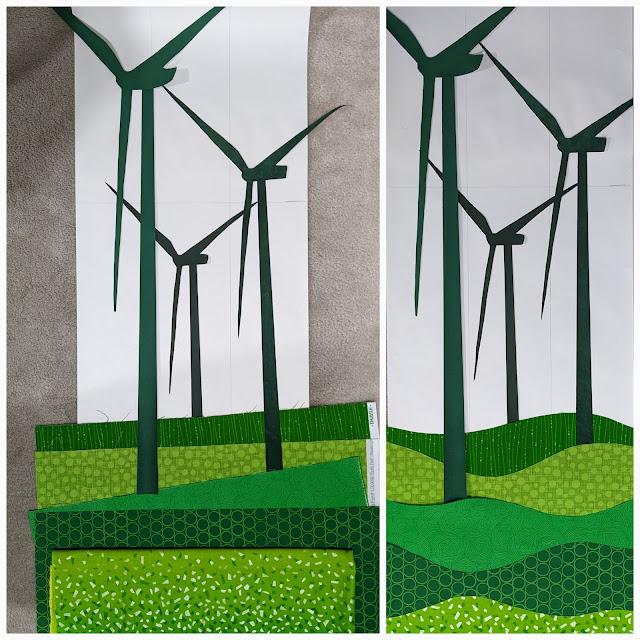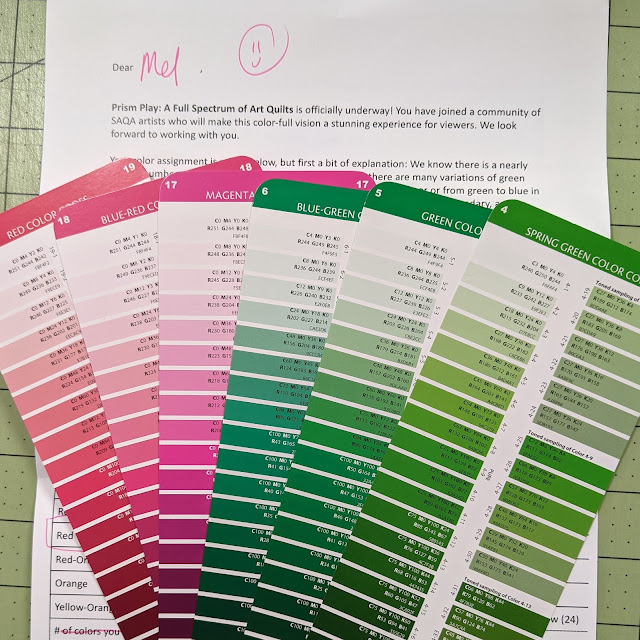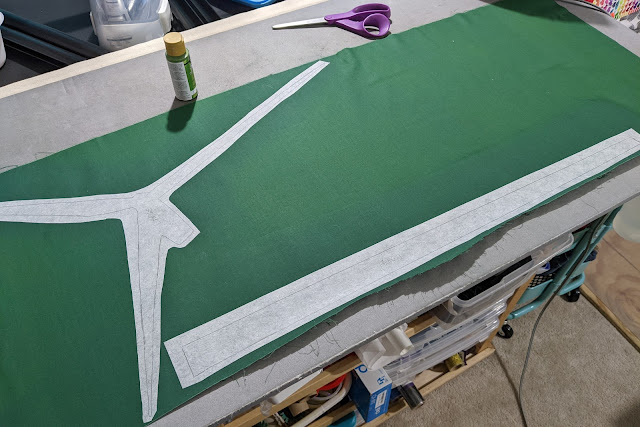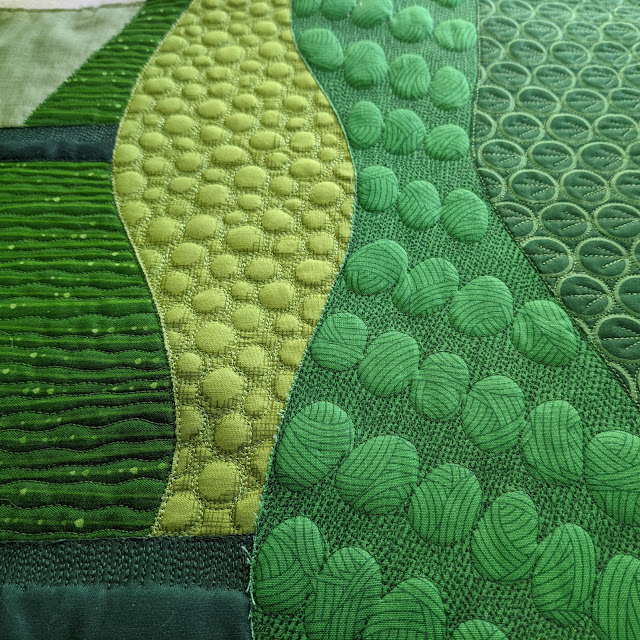When the Northern California/Nevada Region of Studio Art Quilt Associates announced their new exhibit entitled Prism Play: A Full Spectrum of Art Quilts, I was pretty excited to participate. The exhibit "will allow gallery visitors to view a vibrant spectrum of color as though they were standing inside a prism." Color expert Joen Wolfrom was not only the juror, but we would be using her
Ultimate 3-in-1 Color Tool as a color reference. Each participant would create one or more 15" x 45" long, narrow panel based exclusively on a single color card, which included the pure color, tints, shades, and tones. No pure black or white could be used. Participating artists had the option to request certain color cards or to receive a random assignment. My random assignment include two groupings:
- Red which included Red, Blue-Red, and Magenta as options
- Green which included Blue-Green, Green, and Spring Green
Read on to learn more about my design process for creating my piece inspired by the Spring Green Color Card...
My first step was to raid my entire fabric stash for any fabric that fit within any of my assigned cards, eliminating any fabrics that included black, white, or any other color not on my assigned color cards. This was a challenge in itself but I was pleased to have a decent selection for each of the color cards. Just in case, I made paint swatches in case I needed to paint/overpaint any fabrics. Marking pens were also auditioned, along with pulling out green threads.
I opted to focus on Spring Green as I had the largest range of values (tints, tones, and shades) that matched the color card.
The color green embodied "Going Green," adopting environmentally friendly practices and ecologically responsible lifestyle choices to protect the environment in effort to conserve our natural resources for future generations. The 15" x 45" tall, vertical panel size was perfect for exploring wind energy, a renewable energy source. I studied images of wind towers, wind turbines, wind farms, and wind graphics, in addition to researching the many benefits of wind energy to incorporate into my piece.
Here are my rudimentary windmills using rolled and folded fabric to audition value, placement, scale, and background.
Once I narrowed down my fabric palette to include a variety of fabric values and patterns, it was time to start fusing and cutting out my three large windmill towers (while trying to minimize fabric waste--which seemed like a hopeless cause given the unusual shapes of the rotating blades).
Depth of the three windmills was enhanced through the use of three shades of green, in addition to their scale and placement within the landscape layout.

My first attempt to create the illusion of wind was to create these wispy cloud formations, which seemed to detract from the windmills, even after I tried scaling them down in number and size.
Ultimately, the wispy clouds were scrapped as I shifted my efforts towards using stitched texture to create the wind's movement. When I couldn't find my bendable curve, I cut lengths of yarn to audition potential wind waves that would blow in and around the wind turbines. A few different free-motion motifs were doodled as potential fillers.
Once the placement of the nesting curves was finalized, they were drawn onto tracing paper and cut out to use as stitching templates. There I go trying to sneak those wispy clouds back into the sky, only to realize once again that they were detracting from the windmills.
But first, I needed to stitch down the wind towers and turbines. Dense zig zag stitching created light and shadow along the blades and towers, along with a few details along the turbines.
Blue painter's tape to the rescue to secure the paper templates in place as I stitched around to create the curvy outlines that were then filled with spirals, nesting C-curves, and other wind-inspired filler motifs.
Many windmills are installed on working farms and ranches, which generates additional income for the farmers/ranchers for use of their land. As you can see, I had a lot of fun transforming those rolling hills with lots of stitched textures to represent the coexistence with the agriculture sector.
This was a new-to-me motif that was super fun to stitch following these mark-free steps:
- Use strips of 1.5" wide blue painter's tape to space out diagonal rows.
- Stitch a row of arcs that bump up towards the blue tape and less than halfway into the open space. Don't worry about making the arcs all the same size/width.
- Travel back stitching upside down arcs that mirror the first row, leaving space below. Again, don't worry about making the arcs all the same size or even connecting with the previous arcs.
- Fill in the negative space with dense zig zags.
I wanted to include a few facts about wind energy use in the United States and highlight a few of the many environmental and economic benefits. Sakura Gelly Roll pens were perfect for adding small snippets of text onto the towers as well as into the background space.
The background facts were outlined with stitched clouds and surrounded with a long wavy meander.
The scariest step was trimming down the quilted panel to finish at 15" x 45" once faced. It required 4-5 different rulers and repeat measurements before trimming off the excess to achieve a perfect 15" x 45" finished piece. Phew!!
 |
| "WIN-WIN Wind Energy" Finishes 15" x 45" |
Here is my accompanying Artist's Statement:
As I drive past the 2700 windmills in the Palm Springs Desert and nearly 5000 towers along the Altamount Pass, I am struck by the awe-inspiring vista of so many windmills turning in unison. When viewed from a distance, the towers look small and unassuming. It's hard to believe that many are the same height as the Statue of Liberty and collectively, they generate enough energy to power nearly 18 million American homes annually!
Over the past decade, the US has made great strides to harness the wind's energy, which has yielded both environmental and economic benefits. Windmills provide a sustainable green win-win (or "wind-wind") solution for powering our homes and businesses, and our economy in the form of manufacturing and creating jobs.
This piece was finished 4 days before the entry deadline. Stay tuned to see if I was ambitious enough to start and finish a second entry piece within the remaining 3.5 days...

















Comments
Post a Comment
I am delighted you took the time and thought to leave me a comment. It may take a day or two for your comment to appear as I moderate them prior to posting to filter out spam and inappropriate content. Cheers!